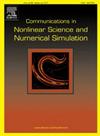An efficient D-RBF-PU method for parabolic PDEs on evolving surfaces based on ALE framework
IF 3.4
2区 数学
Q1 MATHEMATICS, APPLIED
Communications in Nonlinear Science and Numerical Simulation
Pub Date : 2025-02-24
DOI:10.1016/j.cnsns.2025.108685
引用次数: 0
Abstract
In this paper, we propose an efficient mesh-less method which combines the direct radial basis function partition of unity (D-RBF-PU) method and arbitrary Lagrangian–Eulerian (ALE) framework for solving parabolic PDEs on the evolving surface. The evolution mode of surface is obtained by the D-RBF-PU method for solving the forced mean curvature flow (FMCF). The new method maintains the quasi-uniformly distributed of points by setting a suitable tangential velocity and is called the “ALE D-RBF-PU” method. Furthermore, we verify the method is more stable and has higher accuracy than the D-RBF-PU method which is designed based on the Lagrangian framework. Besides, the RBF-PU method relies on a set of patches to assemble the differentiation matrix. Hence, this method is faster than the RBF-FD method for parabolic PDEs on the evolving surface. Numerical experiments confirm the convergence, stability and other characteristics of the proposed method.
求助全文
约1分钟内获得全文
求助全文
来源期刊

Communications in Nonlinear Science and Numerical Simulation
MATHEMATICS, APPLIED-MATHEMATICS, INTERDISCIPLINARY APPLICATIONS
CiteScore
6.80
自引率
7.70%
发文量
378
审稿时长
78 days
期刊介绍:
The journal publishes original research findings on experimental observation, mathematical modeling, theoretical analysis and numerical simulation, for more accurate description, better prediction or novel application, of nonlinear phenomena in science and engineering. It offers a venue for researchers to make rapid exchange of ideas and techniques in nonlinear science and complexity.
The submission of manuscripts with cross-disciplinary approaches in nonlinear science and complexity is particularly encouraged.
Topics of interest:
Nonlinear differential or delay equations, Lie group analysis and asymptotic methods, Discontinuous systems, Fractals, Fractional calculus and dynamics, Nonlinear effects in quantum mechanics, Nonlinear stochastic processes, Experimental nonlinear science, Time-series and signal analysis, Computational methods and simulations in nonlinear science and engineering, Control of dynamical systems, Synchronization, Lyapunov analysis, High-dimensional chaos and turbulence, Chaos in Hamiltonian systems, Integrable systems and solitons, Collective behavior in many-body systems, Biological physics and networks, Nonlinear mechanical systems, Complex systems and complexity.
No length limitation for contributions is set, but only concisely written manuscripts are published. Brief papers are published on the basis of Rapid Communications. Discussions of previously published papers are welcome.
 求助内容:
求助内容: 应助结果提醒方式:
应助结果提醒方式:


